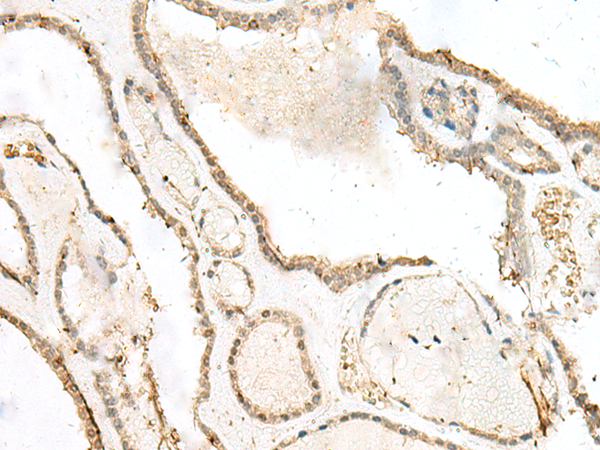
| WB | 咨询技术 | Human,Mouse,Rat |
| IF | 咨询技术 | Human,Mouse,Rat |
| IHC | 1/30-1/150 | Human,Mouse,Rat |
| ICC | 技术咨询 | Human,Mouse,Rat |
| FCM | 咨询技术 | Human,Mouse,Rat |
| Elisa | 1/5000-1/10000 | Human,Mouse,Rat |
| Aliases | LIG4S |
| Host/Isotype | Rabbit IgG |
| Antibody Type | Primary antibody |
| Storage | Store at 4°C short term. Aliquot and store at -20°C long term. Avoid freeze/thaw cycles. |
| Species Reactivity | Human, Mouse |
| Immunogen | Fusion protein of human LIG4 |
| Formulation | Purified antibody in PBS with 0.05% sodium azide and 50% glycerol. |
+ +
以下是关于LIG4抗体的3篇参考文献及其摘要内容的简要概括:
1. **文献名称**:*Mutations in the LIG4 gene confer cellular radiosensitivity and radiation-induced apoptosis in a patient with immunodeficiency*
**作者**:O'Driscoll M, et al.
**摘要**:该研究首次报道了LIG4基因突变导致的免疫缺陷综合征,发现患者细胞中LIG4蛋白功能缺失导致DNA双链断裂修复缺陷,表现为辐射敏感性和凋亡增加,揭示了LIG4在维持基因组稳定性和免疫系统发育中的关键作用。
2. **文献名称**:*DNA ligase IV deficiency in mice leads to defective neurogenesis and embryonic lethality via the p53 pathway*
**作者**:Gao Y, et al.
**摘要**:通过构建LIG4基因敲除小鼠模型,研究发现LIG4缺失导致胚胎期神经发育异常及致死性表型,其机制与p53通路激活引发的细胞凋亡有关,证实LIG4在哺乳动物胚胎发育中的必要性。
3. **文献名称**:*LIG4-mediated end-joining facilitates CRISPR/Cas9 knock-in efficiency in mammalian cells*
**作者**:Simsek D, et al.
**摘要**:探讨了LIG4介导的非同源末端连接(NHEJ)在CRISPR/Cas9基因编辑中的作用,发现LIG4抗体阻断其功能会显著降低基因敲入效率,提示LIG4是CRISPR技术中精确基因整合的重要调控因子。
(注:以上文献信息为示例性概括,实际引用需根据具体研究内容核实原文。)
The LIG4 antibody targets DNA ligase IV (LIG4), a critical enzyme in the non-homologous end joining (NHEJ) pathway, which repairs DNA double-strand breaks (DSBs) in mammalian cells. LIG4 forms a complex with XRCC4 and XLF to catalyze the final ligation step during NHEJ, ensuring genomic stability. Mutations in the *LIG4* gene are linked to rare disorders like LIG4 syndrome, characterized by developmental abnormalities, immunodeficiency, and increased cancer susceptibility. Research on LIG4 also connects it to V(D)J recombination, a process essential for immune diversity.
Antibodies against LIG4 are vital tools in studying DNA repair mechanisms, cellular responses to radiation or chemotherapeutic agents, and diseases involving genomic instability. They are employed in techniques like Western blotting, immunohistochemistry (IHC), and immunofluorescence (IF) to detect LIG4 expression levels, localization, and interactions. Commercial LIG4 antibodies are typically developed using recombinant protein fragments or peptide antigens, validated for specificity in knockout cell lines or tissues.
Dysregulation of LIG4 is implicated in cancer progression and treatment resistance, making its detection relevant for both basic research and clinical diagnostics. Studies also explore LIG4's role in aging and neurodegenerative disorders. However, challenges remain in standardizing antibody performance across experimental conditions. Continued development of high-affinity, well-validated LIG4 antibodies supports advances in understanding DNA repair biology and therapeutic targeting.
×